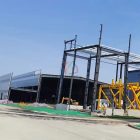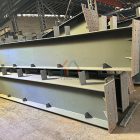Seismic design of multi-storey steel structure buildings
With the acceleration of urbanization, multi-storey steel structure buildings have gradually become an important part of the modern construction field due to their light structure, short construction period and strong plasticity. However, earthquakes, as a common natural disaster, pose a severe challenge to the seismic performance of multi-storey steel buildings. Therefore, it is particularly important to carry out scientific and reasonable seismic design of multi-storey steel structure buildings.
1. The importance of seismic design
Earthquake is a natural disaster with extremely destructive power. It can release huge energy in a short period of time and cause serious damage to buildings. Although multi-storey steel structure buildings have many advantages, their structural systems may also be damaged or fail under the action of earthquakes. Therefore, seismic design is the key to ensuring the safety and stability of multi-story steel buildings.

2. Basic principles of seismic design
The seismic design of multi-storey steel structure buildings should follow the following basic principles:
- Integrity principle: Design the building as a whole to ensure that the various structural parts can work together under the action of earthquakes and resist the seismic force together.
- Rationality principle: According to the use function, site conditions, fortification intensity and other factors of the building, the structural system, materials, construction measures, etc. should be reasonably selected.
- Economic principle: Under the premise of meeting the seismic requirements, try to reduce the project cost and improve the economic benefits.
3. Key measures for seismic design
- Choose a reasonable structural system: Common structural systems for multi-storey steel structure buildings include frame structure, frame-support structure, cylinder structure, etc. In seismic design, the appropriate structural system should be selected according to factors such as the height, span, and use function of the building.
- Set up energy dissipation and shock absorption device: The energy dissipation and shock absorption device is a device that can consume energy and reduce structural damage under the action of an earthquake. In multi-story steel buildings, eccentric supports, buckling restrained supports and other energy dissipation and shock absorption devices can be set to improve the seismic performance of the structure.
- Strengthen node design: The node is a key part in the structural system, and its seismic performance directly affects the stability of the entire structure. In seismic design, the design of the node should be strengthened to ensure that the node can maintain sufficient bearing capacity and deformation capacity under the action of an earthquake.
- Optimize material selection: Steel is the main material of multi-story steel buildings, and its performance directly affects the seismic performance of the structure. In seismic design, steel with high strength and good ductility should be selected, and the amount and cross-sectional size of the steel should be reasonably controlled.
- Strengthen foundation design: The foundation is the connecting part between the building and the ground, and its stability directly affects the safety of the building. In the seismic design, the foundation design should be strengthened to ensure that the foundation can remain stable under the action of an earthquake.

The seismic design of multi-storey steel structure building is a complex system engineering that requires comprehensive consideration of multiple factors. By selecting a reasonable structural system, setting up energy dissipation and shock absorption devices, strengthening node design, optimizing material selection, and strengthening foundation design, the seismic performance of multi-story steel buildings can be significantly improved to ensure their safety and stability under earthquakes. At the same time, with the continuous advancement of science and technology and the continuous improvement of seismic design theory, the seismic performance of multi-story steel buildings will be further improved.












